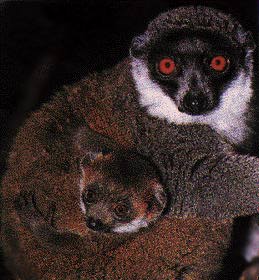

Lemurs
Lemurs are found only on the island
of Madagascar. They are able to live in rain forests, and dry woodlands.
They are both terrestrial and arboreal lemurs as well as nocturnal and
diurnal species. The arboreal time is spent on the larger branches of the
trees, rather than the slim branches.

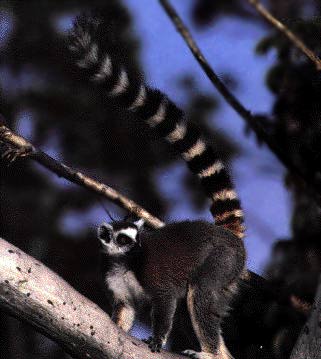 There
is a wide variety of lemurs. The ring tailed lemur (Lemur catta) is identified
by it long black and white striped tail. The back legs tend to be longer
than the front arms. They have scent glands on the underside of their arms,
and near their tails. This suggests that the smell is an important sense.
There
is a wide variety of lemurs. The ring tailed lemur (Lemur catta) is identified
by it long black and white striped tail. The back legs tend to be longer
than the front arms. They have scent glands on the underside of their arms,
and near their tails. This suggests that the smell is an important sense.
Lemurs are quadrapedal, however, the actual gait they use may vary. The tail is used in balancing when they are walking on horizontal branches. They sleep in a semi-erect posture, with the head resting between the knees, and the tail and hands wrapped around the branch.
Lemurs live in large groups consisting
of females and males. There are usually more males than females in the
group. Females tend to be dominant. Sexual behavior is seasonal, probably
ocurring between April and June.
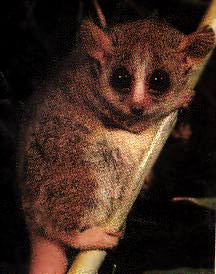
Lemurs come in all sizes. Closely
related Indris are the largest and there are lemurs that are about the
size of a mouse.![]()
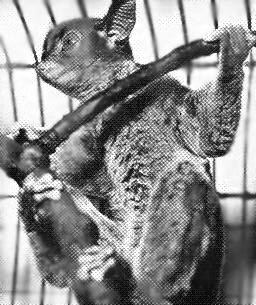 Galagos
are found in the tropical rainforests of Africa, from the Guinea Coast
to the Congo river and to the edge of the Rift Valley. They tend to live
in the low bushes of the forest, not more than 30 feet above the ground.
They are nocturnal and are omnivorous, but show a tendency to eat insects
and the gum from trees.
Galagos
are found in the tropical rainforests of Africa, from the Guinea Coast
to the Congo river and to the edge of the Rift Valley. They tend to live
in the low bushes of the forest, not more than 30 feet above the ground.
They are nocturnal and are omnivorous, but show a tendency to eat insects
and the gum from trees.
Galagos use urine marking as a way to establish territory. Their dental pattern is 2:1:3:3:3; a total of 36 teeth. The maxillary canines are relatively large.
Galagos are verticle clingers and leapers. Some can actually jump up to 150 feet. On the ground they tend to hop bipedally. The social life of these animals is not well known. They are hard to study because of their size, quietness, and nocturnal behavior.
Galago hands are very unique. The
fourth finger is the longest digit and the second finger is the shortest.
The nails are very pointed and are called needle nails.
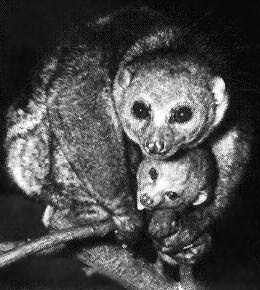 Pottos
Pottos
Pottos appear to be solitary animals
in the wild. They have a gland, near their tail that is used for scent
marking. Their reproductive cycle is not well known.
Pottos are slow moving quadrapeds.
They rely on the strong grips of the hands and feet for stabilbity. They
will slowly move from one branch to another, releasing only one limb at
a time. The hindlimbs are slightly longer than the forelimbs. Pottos rest
in a horizontal or vertical position. The body is rolled into a ball. They
rarley come down to the ground.
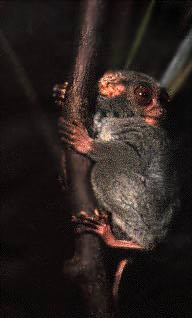 Tarsiers
are found in South East Asia. They live in tropical rain forests, usually
near coastal areas.
They are true vertical clingers and leapers.
They are able to leap from trunk to trunk very rapidly. They can jump up
to 6 feet.
Tarsiers
are found in South East Asia. They live in tropical rain forests, usually
near coastal areas.
They are true vertical clingers and leapers.
They are able to leap from trunk to trunk very rapidly. They can jump up
to 6 feet.
Tarsiers have an unique dental formula. The dental formula for the upper jaw is 2:1:3:3, but for the lower jaw it is 1:1:3:3. They eat insects, lizards, and spiders.
The tip of the hands and feet have very large pads, and there are nails on all digits except for the second and third toe. On these two toes, there are claws. The foot is elongated in the region of the ankle and the big toe is very divergent from the other toes. The fibula, in the lower leg, is partially fused with the tibia. They are nocturnal.
Tarsiers are sometimes found in
male/female pairs, but there have been many sightings of females alone
with her children. They are very territorial, and spend up to 30% of their
time on the ground urine marking their area. It appears that they are able
to breed continuously.
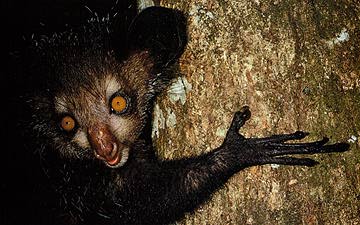 seed,
so they use their elongated third finger to open the seed up and pull out
the tasty morsel. The third finger is also used to extract the pulp of
fruit.
seed,
so they use their elongated third finger to open the seed up and pull out
the tasty morsel. The third finger is also used to extract the pulp of
fruit.
They are quadrupedal, possibly moving in an adapted vertical clinging and leaping mode. When they rest, they roll into a ball with its tail wrapped around its body. Aye-Ayes are solitary.
The hands of an Aye-Aye are specialized
for the manner in which they get their food. The third finger is as least
two times larger than the second finger. There are claws on all the digits,
except for the big toes. The third finger has been described as wire-like.